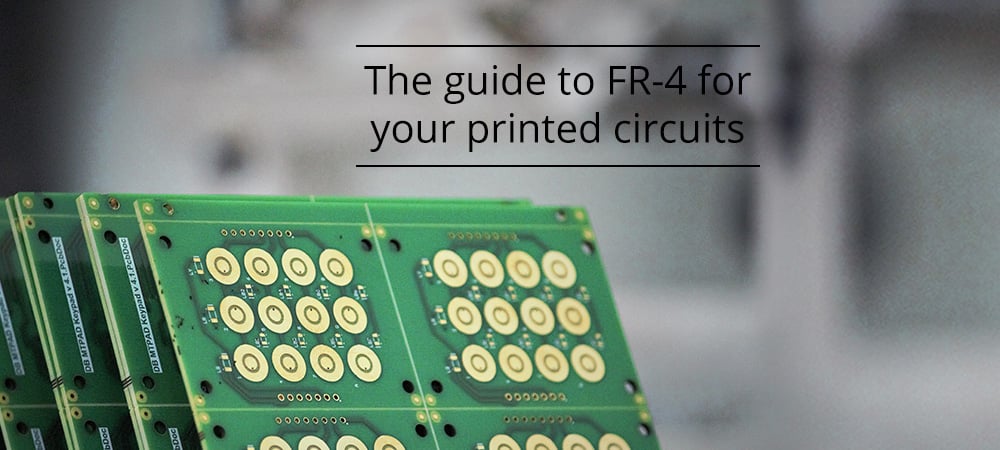
FR-4 or FR4’s properties and characteristics make it very versatile at an affordable cost. This is why its use is so widespread in printed circuit production. Therefore, it is normal that we include an article about it on our blog.
In this article, you will find out more about:
- The properties and benefits of FR4
- The different types of FR-4
- The factors to consider when choosing the thickness
- Why choose FR4?
- The types of FR4 available from Proto-Electronics
FR4 properties and materials
FR4 is a standard defined by the NEMA (National Electrical Manufacturers Association) for a glass-reinforced epoxy resin laminate.
FR stands for “flame retardant” and indicates that the material is compliant with the UL94V-0 standard on plastic material inflammability. The 94V-0 code can be found on all FR-4 PCBs. It guarantees the non-propagation of fire and its rapid extinguishing when the material burns.
Its glass transition (TG) is of the order of 115°C to 200°C for the High TGs or HiTGs depending on the manufacturing methods and the resins used. A standard FR-4 PCB will have a layer of FR-4 sandwiched between two thin layers of laminated copper.
FR-4 uses bromine, a so-called halogen chemical element that is fire resistant. It replaced G-10, another composite that was less resistant, in most of its applications.
FR4 has the advantage of having a good resistance-weight ratio. It does not absorb water, keeps high mechanical strength and has a good insulating capacity in dry or humid environments.
Examples of FR-4
Standard FR4: as its name indicates, this is the standard FR-4 with heat resistance of the order of 140°C to 150°C.
High TG FR4: this type of FR-4 has higher glass transition (TG) of around 180°C.
High CTI FR4: Comparative Tracking Index higher than 600 Volts.
FR4 with no laminated copper: ideal for insulation plates and board supports.
There are more details of the characteristics of these different materials later in the article.
Factors to consider when choosing the thickness
Compatibility with components: even though FR-4 is used to produce many types of printed circuit, its thickness has consequences on the types of component used. For example, THT components are different from other components and require a thin PCB.
Space saving: space saving is essential when designing a PCB, in particular for USB connectors and Bluetooth accessories. The thinnest boards are used in configurations in which space saving is crucial.
Design and flexibility: most manufacturers prefer thick boards to thin ones. Using FR-4, if the substrate is too thin, it would be under risk of breaking if the board dimensions were increased. On the other hand, thicker boards are flexible and make it possible to create V-grooves.
The environment the PCB will be used in must be considered. For an electronic control unit in the medical field, thin PCBs guarantee reduced stress. Boards that are too thin - and therefore too flexible - are more vulnerable to heat. They can bend and take on an undesirable angle during the component soldering steps.
Impedance control: the board thickness implies the dielectric environment thickness, in this case FR-4, which is what facilitates impedance control. When impedance is an important factor, the board thickness is a determining criterion to be taken into account.
Connections: the type of connectors used for a printed circuit also determines the FR-4 thickness.
Why choose FR4?
The affordable cost of FR4s make them a standard option for the production of small series of PCBs or for electronic prototyping.
However, FR4 is not ideal for high frequency printed circuits. Similarly, if you want to build your PCBs into products that do not easily allow the adoption of components and that are little suited to flexible PCBs, you should prefer another material: polyimide/polyamide.
The different types of FR-4 available from Proto-Electronics
Standard FR4
- FR4 SHENGYI family S1000H
Thickness from 0.2 to 3.2 mm. - FR4 VENTEC family VT 481
Thickness from 0.2 to 3.2 mm.
FR4 High TG
- FR4 SHENGYI family S1000-2
Thickness from 0.6 to 3.2 mm. - FR4 VENTEC family VT 47
Thickness from 0.6 to 3.2 mm.
FR4 High IRC
- FR4 SHENGYI family S1600
Standard thickness 1.6 mm. - FR4 VENTEC family VT 42C
Standard thickness 1.6 mm.
FR4 with no copper
- This material is an epoxy glass with no copper, designed for use in insulation plates, templates, board supports, etc. They are manufactured using Gerber type mechanical drawings or DXF files.
Thickness from 0.3 to 5 mm.
and get your PCBA quote within the next 10 minutes!



